Samsung’s flagship line of Galaxy smartphones has enjoyed a level of success paralleled only by Apple’s iPhone, and the latest of these devices – the Samsung Galaxy S5 – just launched.
The tech world has come to expect excellence from the Galaxy S series, but has Samsung created another device that wows or simply one that keeps pace? And perhaps most importantly, should you spend your hard-earned money on the Galaxy S5, go for a competitor, or wait for the next big thing? Find out in our full review below.
Galaxy S5 Hardware & Design
The Galaxy S5 is packed full of hardware upgrades that the untrained eye wouldn’t likely spot at first glance. The fingerprint sensor baked into the home button. The heart rate monitor paired with the flash. The added charger door ensuring water resistant status. All brand new.
Bigger screen. Bigger battery. Bigger camera. Bigger processor. All stuffed into a device that’s unnoticeably bigger than its predecessor- a mere handful of millimeters larger and only a few grams heavier. You’ll read reviews labeling the Galaxy S5 as “iterative” and “evolutionary not revolutionary” – which may be true – but when you consider these improvements in context, relative to the maturity of the smartphone market, I’d argue that what Samsung has accomplished with the S5 is incredibly impressive.

The biggest visual change with the Galaxy S5 is found on the rear, where Samsung has opted for the dimpled faux leather a la the Galaxy Note 3 rather than the glossy shell of the Galaxy S4. It’s an improvement, but it also continues Samsung’s infatuation with plastic (like it or not), though credit them with a step in the right direction.
The 5.1-inch Super AMOLED display is full HD (1920 x 1080) and absolutely gorgeous, offering the most vibrant colors of any smartphone on the market. Some might complain it has too much contrast and looks artificial – a matter of opinion with which I disagree but can appreciate – and to accommodate this viewpoint Samsung allows users to adjust screen saturation in the Display settings. The clarity, quality, and viewing angles of the screen make it a real joy to use day-in and day-out.
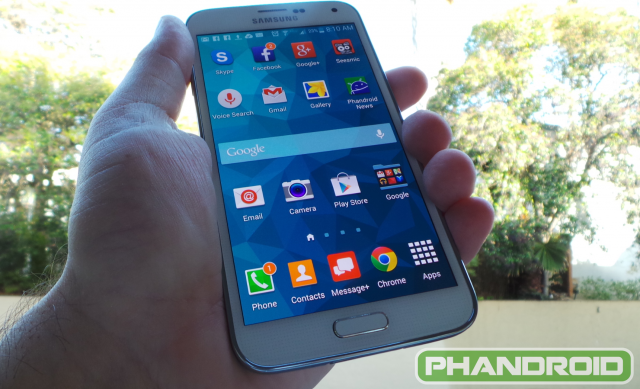
The S5 layout matches the S4 in almost every way, with volume buttons on the left side, power button on the right side, MicroUSB 3.0 charging port on the bottom, and 3.5mm headset jack and IR blaster on the top. The home button now doubles as a fingerprint scanner and is flanked by two capacitive buttons: multi-tasking on the left and back button on the right.
You can hold down the multi-tasking button to pull up any screen’s menu, hold down the home button for Google Now, and optionally set a double tap of the Home button for S Voice – all very convenient.
An ear piece at the top rests above the Samsung logo, to the left of which you’ll find an LED light and to the right of which you’ll find a couple ambient light sensors and a front facing 2MP camera.
Flip over the S5 and you’ll see the huge and very capable 16MP camera at the top. Just below it is a recessed groove that houses a flash for the camera and an all-new heart rate monitor. A tiny speaker grill at the bottom left of the back adds more audio power.
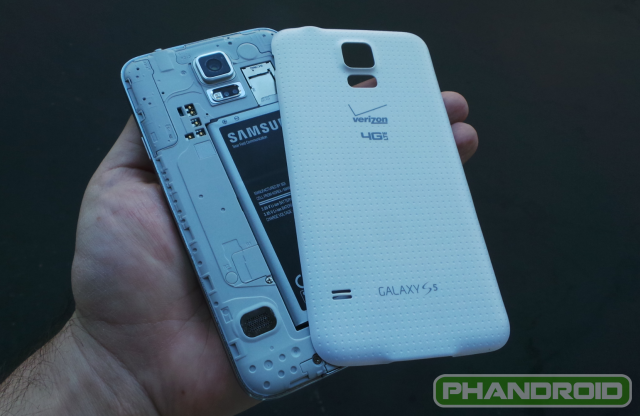
Pop open the back cover for access to the 2,800 mAh battery, SIM card slot, and MicroSD slot (up to 128GB in addition to the 16GB or 32GB of onboard storage). The S5 is amply powered by a 2.5GHz quadcore processor (Qualcomm Snapdragon 801), Adreno 330 graphics unit, and 2GB of RAM.
On the surface the total package may seem rather unremarkable: we’ve grown familiar with the Galaxy S design standards and Samsung has decided not to stray from a formula that’s consistently yielded results. Samsung should be careful to not let familiarity become fatigue, though. And as tech enthusiasts we should realize that our clamoring for “the next big thing” can be a distraction from what matters here and now.
Samsung has not only improved every nook and cranny of an already fantastic phone, they’ve also added completely new hardware features, done so without increasing size, and made it available at the same price. On paper it’s difficult to ask for much more, so long as in practice everything performs as you’d expect. But does it?
Let’s start with the three newest features: weatherproofing, finger print scanner, and heart rate monitor.
Weatherproofing and Water Resistance
Samsung won’t make the mistake of telling you the Galaxy S5 is waterproof, but for all intents and purposes, the Galaxy S5 is waterproof. The technical classification of Samsung’s weatherproofing is IP67 certification which Samsung describes as, “resistant to sweat, rain, liquids, sand and dust, so your phone is protected for any activity and situation.”

The technology has been around for years but few manufacturers have made it a staple of their flagship phones: bravo to Samsung for including this on the S5. Weatherproofing adds immediate and tangible value by acting as an insurance policy: water damage ranks up there with lost phones, stolen phones, and cracked screens for top reasons smartphones require replacement.
We don’t suggest you go swimming with the S5, but if you drop it in the toilet, use it in the rain, or even take it with you in the shower you shouldn’t have any problem. Just make sure the back cover is snapped on around the entire circumference of the phone and the charging door is closed… it doesn’t perfectly seal every time you take it on and off so a little paranoia will go a long way.
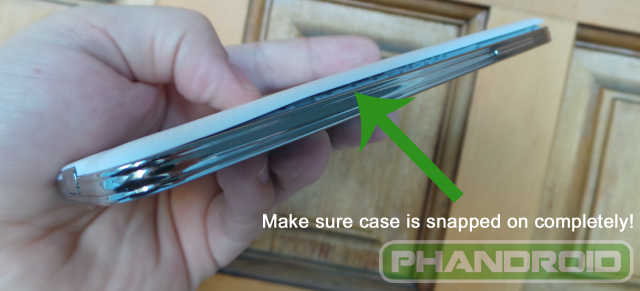
The battery door is a tad annoying to open and close at every charging pitstop – a wireless charging solution would have provided an elegant alternative – but the minor inconvenience is well worth the added value.
In years past manufacturers were happy to collect on your clumsiness, but hopefully the most popular smartphone manufacturer weatherproofing their most popular device will help the practice become as commonplace as WiFi and Bluetooth. This might be downplayed as a minor upgrade from the S4, but in the grand scheme of things, weatherproofing makes a world of difference.
Finger Sensor
There are two ways you can look at Samsung’s addition of a finger sensor for fingerprint scanning in the Galaxy S5:
- A “me too” feature that follows in Apple’s footsteps, erasing one selling point potentially swaying consumers towards the iPhone 5S over the Galaxy S5.
- A response to the increased exposure that the topics of privacy and data security are attracting in the court of public opinion.

I’ll be honest: Samsung’s fingerprint scanner isn’t as good as Apple’s. Not even close. But whereas Apple’s core functionality is focused on letting you unlock your phone, Samsung has left the door open for developers to integrate finger scanning functionality in their apps through Samsung Accounts. Two examples: use your fingerprint to make immediate payments with Paypal or gain access to locked files on your phone that you’ve set as private.
Unfortunately the Samsung finger scanning experience has two key drawbacks. First, you’ve got to slide your finger over the home button with such precision that it requires two hands. Second, the delay between registering a successful fingerprint and actually unlocking your device is too long to make it efficient.
It’s undoubtedly a cool feature and one I would consider using at the application specific level, but not quite ready for primetime for the most frequently accessed activity on your phone: unlocking it. Still, this could prove a smart move by Samsung if for nothing more than acting as an iPhone stopgap.
Heart Rate Monitor and S Health
If the finger sensor is meant to go tit-for-tat with Apple then Samsung’s Heart Rate Monitor can be considered a display of oneupmanship. Found in a recessed groove below the camera and sitting next to the flash, the Heart Rate Monitor might seem like a completely random addition, but it ties in well with Samsung’s push towards offering lifestyle solutions, especially in health and fitness.
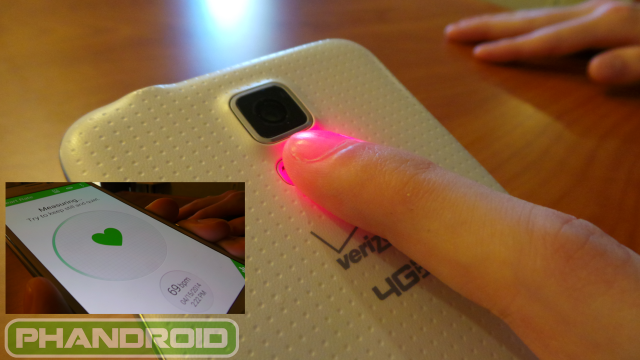
How many people care about monitoring their heart rate? Fitness fiends might enjoy the added ability, but it’s also likely they’ve got a separate wearable – perhaps even one of Samsung’s own Gears Smartwatches – that accomplishes the same task more accurately.
The Heart Rate Monitor suffers in much of the same way as the Finger Scanner: if you don’t get your finger positioned just right it’ll frustratingly feed you with an error message and ask you to try again. And again.
 S Health as a lifestyle initiative is starting to look very promising. Grouped with the Gear smartwatches and the heart rate monitor, Samsung is putting together a nice little suite of health and fitness solutions that work together like a cohesive brand. I’m eager to see continued development of S Health, both from a hardware and software standpoint.
S Health as a lifestyle initiative is starting to look very promising. Grouped with the Gear smartwatches and the heart rate monitor, Samsung is putting together a nice little suite of health and fitness solutions that work together like a cohesive brand. I’m eager to see continued development of S Health, both from a hardware and software standpoint.
While I point out these faults, I won’t blame Samsung for trying to innovate: they’ve added three brand new features to the Galaxy S5 with weatherproofing, finger scanning, and heart rate monitoring without increasing the size or cost of the device. None are particularly ground breaking, but all three are welcome additions you can choose to embrace or ignore without consequence thanks to Samsung’s seamless integration.
Galaxy S5 Software
The Galaxy S5 runs on Android 4.4 KitKat with an updated version of TouchWiz that offers a mixed bag experience of both pleasant surprises and letdowns.
For starters, the home screen and app drawer share the same wallpaper and look almost identical. The lack of a transparent overlay or relative sense of orientation is annoying at best and could be a real headache for Android beginners.

That problem is compounded by a huge number of pre-installed apps including duplicates from Samsung and Google, each trying to be the one stop shop that owns the user experience. You can easily uninstall apps in bulk and hide those where removal is not allowed, but the clusterbomb of confusion created by this unorganized landfill of icons is somewhat ridiculous and easily preventable. Instead, users will want to spend several minutes removing stuff when they first get their phone, including apps piled on by your carrier.
Samsung tries to accomplish too much and it translates into a scattered user experience. In some places though, such as the camera UI, Samsung successfully narrows their focus, and the result is a refined UI that’s a breath of fresh air in a too often overwhelming environment.
My Magazine
Aggregated content experiences seem to be all the rage these days and Samsung has returned with their own solution – My Magazine – which has been stripped down to a Flipboard skeleton. Occupying the far left home screen, you can fill it up with your choice of news topics and social networks which will then populate an always-updating feed.

Unfortunately there are a few glaring oddities: Facebook is missing, topical selection is too broad, and most news links abruptly pass you to the Flipboard app rather than existing in a self contained My Magazine ecosystem. With the greatly limited scope of customization and inability to uninstall Flipboard, you’re probably best off removing it (Home Screen > Menu > Home Screen Settings > Uncheck My Magazine).
Samsung is criticized often for going overboard with TouchWiz and perhaps this was an attempt to pull back, simplify the concept, and let Flipboard run the show. If so, they missed the mark. The result is a lackluster offering that should have been scrapped completely.
Settings & Features Overload
Samsung has given the settings area of the Galaxy S5 a nice looking facelift, making square icons circular, flattening images, and relying more on muted colors and pastels. Not only do these look better, they also better match the direction Google is taking Android (consider the circular profile icons in Google+ for example). The only problem is that in some ways they look out of place with the rest of TouchWiz and Android 4.4.

Samsung has had a usable and helpful quick settings tray for as long as I can remember. Pull down notifications with one finger and you’ll see a side scrolling list of icons at the top for quickly toggling on and off. Just below it is an adjustable screen brightness widget that you’ll use frequently. Pull down the notifications with 2 fingers and you’ll be treated to a full menu of quick settings that essentially fill the page. Both of these areas are easily customizable for adding, removing, and re-ordering settings.
One level deeper into the settings and you’ve hit Android Inception, washed up on the shores of Samsung’s subconscious. The Galaxy S5’s main settings menu has 37 top level categories, all with their own list of specific settings and options, most of which have an additional sub-list of sub-settings and sub-options from which to choose. And then, of course, there’s the settings for the settings page.

There is one saving grace here: Samsung puts a search icon front and center, allowing you to search all of your phone’s settings for relevant keywords. This can sometimes ease the pain but it doesn’t alleviate the problem.
Samsung is clearly doing some housekeeping of their own and rethinking the strategy of attempting to control their entire Android ecosystem through Touchwiz. Added value features and settings that Samsung once touted are now buried in the options, most likely because Samsung leadership knows they aren’t being used but parting with proprietary technology can be emotionally challenging.
Samsung should cut their losses on features like Air browse, Palm swipe, Air view, and Easy Mode, focusing instead on more meaningful initiatives that all users would want. It would have the added benefit of allowing Samsung to consolidate their settings, make their devices easier to use, and perfect some really great ideas that currently seem half baked.
That’s not to say Samsung doesn’t have some really great settings and features that we’d be sad to see go. Here are some to which you should pay particular attention:
- Smart Remote – control your TV and home entertainment system with this app thanks to the S5’s IR Blaster. This is a fully featured solution that’s far from a gimmick. Spend a few minutes setting it up and your TV-watching experience is greatly improved.
- Power Saving Mode – quickly jump into either moderate or extreme power saving modes that will shut down or alter phone activity to conserve battery life, including changing your display to black and white. Works great!
- Blocking Mode – prevent notifications and alerts during certain hours and allow certain contacts to bypass the block
- Toolbox – a floating chat-heads style menu that hovers over all screens to give you instant access for up to 5 apps from anywhere in your phone. Defaults to camera, voice recorder, notepad, and calculator which makes a lot of sense. This can get annoying but also be very helpful.
- Active Call – similarly, if you’re browsing your phone while actively on a call, Samsung will show a hover icon of the current contact on top of your active screen, allowing you to easily jump back into the call
Other ideas, like Private Mode, sound good in theory but aren’t executed with enough clarity to make them shine on the S5, perhaps even causing a distraction to the existence and execution of other opportunities.
One small example is comparing Samsung’s text to speech engine with Google’s…
Why even offer this as an option? Could the resources used here have been better allocated elsewhere? Samsung is trying awfully hard to maintain their lead and continue their dominance in the Android universe, but I think at times TouchWiz on the Galaxy S5 proves their ambition is getting the best of both them and their customers.
Let’s be clear: the S5 user experience isn’t bad and on the contrary is quite enjoyable, but as the Galaxy S5 Camera UI revamp goes to show, simplifying, refining, and focusing your approach can go a long way to improving a technology experience. More is not always better.
Galaxy S5 Camera
The Samsung Galaxy S5 has a 16MP camera and 2MP front-facing camera, an improvement from the S4’s 13MP/2MP combination. Technically speaking, you probably wouldn’t notice the 3 megapixel difference between the two generations unless you were printing a poster sized image or zoomed in to focus on a specific portion of the image.
The photo quality of the S5 is on par with the S4: it performs great in daytime with ample light, similarly reliable with macro pictures, but really struggles when lighting and conditions aren’t optimal and the flash can produce washed out results.
The real upgrade with the S5 camera is in the software and features. The camera UI is an absolute breath of fresh air: simple, intuitive, enjoyable, and easy to find what exactly what you want. The main layout has consistency with the shutter buttons, primary modes, and gallery link on the right and more specific camera options on the left.
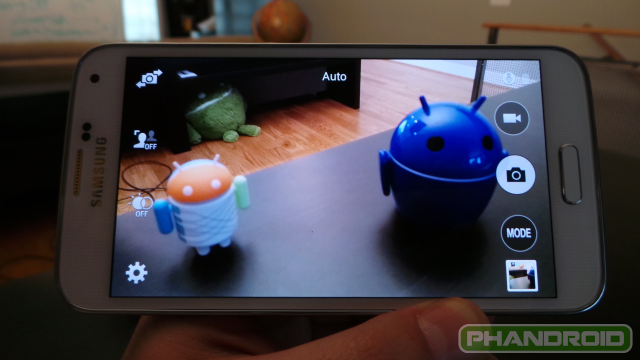
Samsung prioritizes three specific camera toggles:
- Rear vs. Front camera toggle
- Selective focus on/off which can provide the DSLR blurred background effect
- HDR (High Definition Richtones) which converts awkward washed out lighting into rich, vibrant colors
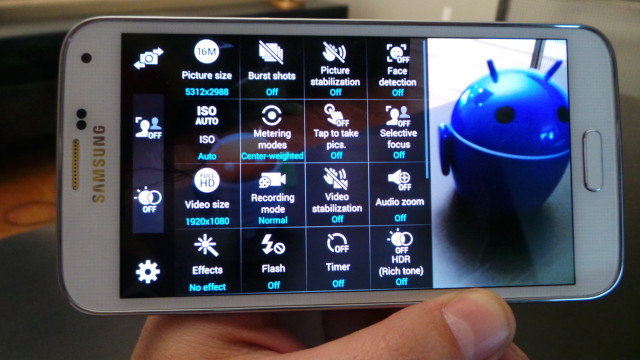
Want to jump into more settings? No problem, the bottom left gear pops open a big menu that lets you fine tune further including options for:
- Picture size – ranging from 6MP to 16MP and 3 different aspect ratios
- Video Size – up to UHD 3840 x 2160
- Recording Mode – normal, slow motion, fast motion, smooth motion, etc…
- Burst Shot Toggle
- Picture Stabilization Toggle
- Face Detection Toggle
- ISO
- Tap screen to take pics
- Audio zoom
- Effects
- Flash Toggle
- Timer
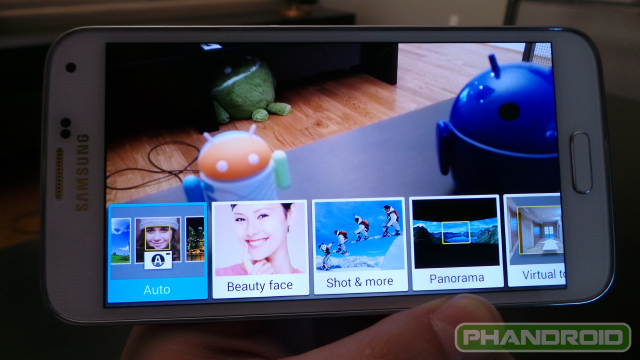
Samsung’s selective focus option is neat when it works (see below), but it’s bit problematic. Your subject has to be a certain distance and ratio from you and the background, and if you’re not, the picture will snap but selective focus won’t activate- this happened to me more often than not. It also takes several seconds to take the picture and process, making candid photos even more difficult. I hope Samsung will continue developing this feature – it’s fun when it works but doesn’t seem ready for prime time just yet.
HDR on the other hand is excellent and can make a world of difference. When in HDR mode the camera preview shown on the S5 screen actively displays your HDR effects in real-time, letting you know exactly how it will look and preventing the guessing game that cameras so often like to play. Its position in the primary options is well deserved and I think its success can partially be attributed to the S5’s quick focus and shutter times. Another nice HDR option: recording HDR video.
Video on the S5 lines up with photos: excellent under the right conditions but obstacles such as dimly lit scenes can cause big problems. The various video modes are fun to play with but you won’t find yourself looking for them often.
 The 2MP front facing camera leaves a lot to be desired (the subject matter doesn’t help in this case) and we’d earmark it for an expected upgrade in the inevitable Galaxy S6.
The 2MP front facing camera leaves a lot to be desired (the subject matter doesn’t help in this case) and we’d earmark it for an expected upgrade in the inevitable Galaxy S6.
Overall the Galaxy S5 camera is a solid improvement. The cleaned up UI makes taking a picture with the preferred settings an absolute breeze and in favorable conditions the photo quality is excellent. However, far too many situations seem adverse for the S5 camera’s capability range, which in turn prevents some cool new features like Selective Focus from functioning properly.
The result is a more than adequate 16MP camera that still won’t replace your point and shoot, but makes us yearn for a day when that’s possible. Until then we think the vast majority of people will be perfectly happy rocking the Galaxy S5, and if not, Samsung would be happy to sell you the Galaxy Camera 2 or the Samsung Galaxy Zoom to fulfill your photographic dreams.
Galaxy S5 Performance & Battery
My experience with the Galaxy S5 was near flawless from a performance and battery standpoint. The 2.5 GHz quad-core Snapdragon 801 processor and its 2GB of RAM seemed to power Android 4.4 KitKat with the greatest of ease. Whether multi-tasking out the wazoo or handling everything Touchwiz could throw at it, I didn’t experience a single hiccup that you can blame on the Galaxy S5’s internals.
I know other reviewers have complained that the S5 seems sluggish at times, blaming the bloatiness of Touchwiz and a processor that can’t keep up but in my personal experience this simply couldn’t be further from the truth. The appearance and organization of the software may seem inconsistent in places, but from a hardware performance standpoint the Galaxy S5 was the definition of quality and consistency.
I was also pleasantly surprised with the Galaxy S5’s battery life, lasting a full day without much difficulty, offering additional battery saving modes for crunch time, with additional comfort knowing that should I choose I could likely upgrade the S5 with an extended battery.

Keeping your battery charged can be a mountain to climb… but not with the S5
The two battery saving modes are called “Power Saving Mode” and “Ultra Power Saving Mode” and can be found in the main settings list. Customize the settings of each and activate them depending on how dire your straits (you cannot activate them both at once).
Power Saving Mode can block background data, limit CPU performance, lower the screen’s frame rate, lower brightness, turn off the capacitive menu and back button lights, turn off GPS, and convert the display to grayscale. I decided to turn off the touch key lights permanently and grew rather fond of grayscale at times.
Ultra Power Saving Mode takes it to another extreme, turning your phone into an “Easy Mode” of sorts. Your screen will turn black and white, you’ll have access to a maximum of 6 apps, and offered practically no additional options until the mode is turned off. You’re able to see your battery percentage and time left on standby, helpful towards tracking your battery conservation efforts in the clutch.
The Galaxy S5’s elite hardware performance combined with great battery life will alone make a lot of customers very happy, especially those coming from older generation phones.
Galaxy S5 Audio & Call Quality
If you plan on cranking up the volume, listening to music, watching videos, and playing games with noise to the max you may want to think again. The S5 can handle moderate sound levels okay, but the higher you take the volume the more tinny and cheap the audio sounds. This is especially noticeable when the device is laying flat on a surface, causing the plastic S5 frame to vibrate and rattle.
Needless to say, when operating the S5 at louder volume letters the multimedia experience leaves a lot to be desired.
I also found speakerphone quality dropped with the device laying flat on the counter; the other caller sometimes complained my voice was muffled. This was sporadic and I was unable to reproduce the effect, so I wouldn’t weigh this heavily into a purchase decision, but keep it in mind. If you plan on listening to loud multimedia on speakerphone regularly, you’ve got a lot more to think about.
Galaxy S5 – The Bottom Line
The Samsung Galaxy S5 is an impressive upgrade to an already great phone. On paper, Samsung has improved their offering in nearly every area imaginable. Aside from packing a more powerful punch in a similarly slender frame, the S5 improves both performance and battery life while retaining the crown for best mobile display.

The most important addition to the Galaxy S5 – weatherproofing – is an invisible feature you won’t use on a daily basis and is consequently overshadowed. It shouldn’t be- its inclusion brings a ton of value to the S5. Instead it’s the finger scanner, heart rate monitor, and 16MP camera that steal the lime light even though their combined real-life improvement from the S4 is likely to be limited.
We’ve grown to expect an awful lot from Samsung, perhaps even holding them to a higher standard, which is why not being absolutely blown away by the S5’s awesomeness seems like a disappointment. The fact remains: the Samsung Galaxy S5 instantly becomes one of the best phones on the market, perhaps is the best all-around phone, and the vast majority of users will be pleased and impressed by its performance. It still has room to improve – especially in camera consistency, audio quality, and UI experience – but the Galaxy S5 once again delivers while leaving us continually yearning for more.
Should you buy it? If you’re due for an upgrade the Galaxy S5 should occupy one of the tops spots on your short list, along with the HTC One M8 and perhaps a couple others. It doesn’t warrant an upgrade fro the S4 and audiophiles should steer clear, but if you’re due for an upgrade and/or love the cutting edge of tech, the Galaxy S4 is a great choice.
The Good:
- Amazing, best-in-market screen
- Weatherproofing is a hugely valuable addition
- Among most powerful and consistent performers
- Strong battery life with additional battery saving modes
- Finger Scanner and Heart Monitor are fun additions that add zero bulk
The Bad:
- Software options can be overwhelming and scattered
- Tinny and subpar audio when played at high volumes
- Camera is inconsistent in less than optimal conditions
Overall Score: 4.5 out of 5





















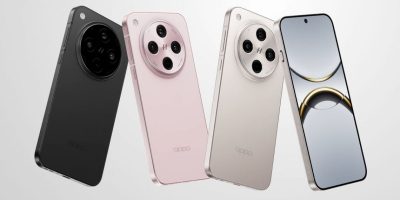
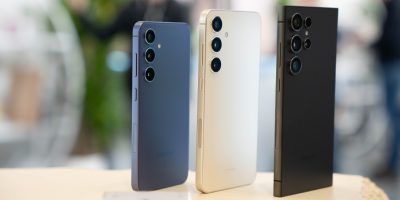







A nice, thorough review. Great job, Rob. As a former dedicated Galaxy owner (Epic 4G, E4GT, GS3, GS4), I’m happy to see the battery life improved even without use of either power saving mode. I would be a little skeptical of jumping into an extended battery until we see if any of the aftermarket companies come up with an IP67 rated battery cover.
7-8 hours of screen on time is sufficient without the need of an extended battery : )
BTW, The audiophile part is a bit unfounded. I’m not sure if the S5 uses the same DSP as the Note 3 does but Samsung has a history of putting some nice audio output chips on their phones and indeed, sound quality through headphones and bluetooth devices is quite excellent for the Galaxy Devices I’ve owned in the past.
The speaker? Yeah it sucks. Who uses that to listen to music anyways?
lots of people use speakers – imagine taking your phone to the beach now its waterproof and playing music, or how about loud sound for in car directions. I use that a lot on my HTC M7. Too bad the GS5 has no FM Radio. I need that feature.
When I’m at the beach, I have my Bluetooth dock. I have Bluetooth in my car as well to handle my music/directions. Or I just cast to my TV via my XBox One/Chromecast when I’m at home, so a speakerphone becomes moot in my situation. Of course for those who don’t use extra accessories, I do see the value in a quality speaker. I’m totally with you on the FM radio though!
My bluetooth speaker works great since I usually have my phone in its dry bag at the beach – more so to protect it from sand than water.
Jawbone big jambox ftw!
There aren’t any apps you could use? Or is the hardware just not there at all?
I think it’s a case of the hardware not being there. Since whatever radio apps you download are data dependant, if you hit a dead zone, or you’re in bad coverage, then you’re SOL.
The HTC One owners do.
I agree that if you use headphones it is a different story. Personally, I use my speakers a LOT for various purposes and if you truly enjoy the option of cranking audio – for whatever the purpose – it’s a pretty disappointing experience.
But if you’ve go to headphones that you use religiously, sure, take that criticism out of the equation. Everyone uses their phones differently.
This sounds like a cheap plug for the PhanBot ;)
Me. I play a lot of games on my phone and when I’m at home, I play through the speakers. I had to move my computer speakers onto my bed because the quality was just no.
The same goes for the 3DS. They outta line for that speaker quality.
They started from the bottom and now they here. Too bad their software and radios are still bad =0(.
Gs5 best phone out. No question. Note 3 second
In the toilet? Why? That’s just nasty.
To show it’s both water proof and p1$$ proof? There are some who “party” and get drunk and end up dropping their phone in the toilet.
That Dos Equis picture was taken earlier before the toilet picture.
You speak the truth.
IP67 is amazing. I hope this is a sign of things to come with smartphones. This phone clearly isn’t for me as it’s just too big and don’t like TouchWiz, but it’s obvious they’ve made progress in other ways.
Great review. This phone has everything I want and very well may be my next phone.
Its definitely my next phone!
I hope that was a test toilet. You know just for the sole purpose of testing phones and not for ones and twos. Haha
Nice review! I know a full day could mean different things to different people, so concerning battery life: When you say it’s last you through the day, how many hours is that? What paces do you put through your device? What level of brightness do you keep your phone at?
As far as the fingerprint scanner, I’ve got it where I can scan with one hand and it will register me on the first try at least 98% of the time. The trick is to hold the phone one handed as you would naturally and swipe the finger (in my case thumb) at different angles when registering your print, I did that for both of my thumbs. I do wish that you could register more than three fingers though!
Regarding the battery use it varies, but I’d say on a normal day I’m doing heavy web surfing and e-mail with a ton of stuff loading in the background, an hour of music and/or youtube, maybe 30 minutes of gaming, usually google maps at some point in the day.
For testing purposes I was doing a lot more of everything and I was still getting through the day easily. Especially using the camera WAY more than I normally would for both pictures and videos. Some of the pictures and videos on my phone from the weekend indicate the battery life may have lasted a little TOO long *shakes head*
Will definitely have to try your fingerprint suggestion a few times and see if it improves.
Here’s a look at all the TORTURE Tests combined. http://www.ibtimes.com/samsung-galaxy-s5-torture-test-rundown-see-2014-flagship-tossed-trampled-beaten-videos-1572755
Great review. I guess that puts an end to all that crying about the S5 being not a decent improvement over the S4. (Specially the crying coming from HTC fan boys, haha)
So…..Rob….for all the places you could test the IP67 rating, you chose a toilet? As @JQuest81:disqus stated, I really hope that was a test toilet lol
Don’t worry, I made sure the water was clean and safe for the S5 by doing a taste test first.
i really wish this phone didnt have that home button…. still torn between this and z2 and m8.
Comparison between S5 and M8 coming soon… probably tomorrow AM… stay tuned :)
woot woot
I hope that you’ll do not only the inevitable camera comparison but also actually test the phone and wifi radios! It would be really nice finally to see a phone review that discusses the ability to…make a call and download data!
I bought the Verizon S5 full retail, to keep unlimited data. The camera, display, and battery are the best available. Getting 7-8 hours of screen on time is a breath of fresh air!
Just spent two hours at T-Mobile, deciding between this and the M8. Went with the M8, but good review of this all the same. I liked the store model well enough but this is just an uglier version of the S3 (which was the best-looking of this form factor) and the software upgrades, while nice, just weren’t enough to hook me this time around. I hope the S 6 is more impressive (for me).
Little bit of a teaser but, based on the comparison of the two I’ll be posting in a few hours, you made the same choice I would have.
“HDR (High Definition Richtones) which converts awkward washed out lighting into rich, vibrant colors”
That’s not what HDR stands for. It usually stands for “High Dynamic Range”. It’s meant to help the camera deal with extreme light level ranges so that the resulting image/video doesn’t suffer from blown out highlights (usually the sky), or pitch back shadows. Before phones and cameras did this automatically, it was done by actually combining exposures from different shots using photoshop or another program. Things are easier now that the phone can do this all in one step. The S4 does it decently, but I understand that the S5 is even faster at processing it, and can now do it for video :).
Look here to see the types of light situations for when it’s a good time (and not a good time) to use the feature. http://lifehacker.com/5991508/what-is-hdr-and-when-should-i-use-it-in-my-photos
Correct. But don’t blame the writer he just made a mistake and you know that everyone makes mistakes.
I want this for the battery life alone.
With respect to the speech engine, more review and less snarkiness would have been really helpful. I would love a better alternative to the google speech engine! At the moment, it’s not great (to be kind) and some Android-based competition might be good.
You might want to try something like SVOX for text to speech. I personally think it sounds really good and let’s you fine tune the speed and pitch of the voice etc.. The one down side is Google voice navigation seems to always use the Google engine even if you have the default set to something else. That may be what you were referring to I’m not sure. But that is annoying I’ll agree.
I’d like to see something like that TomTom GPS had a few years back where you could select novelty voices for GPS like Morgan Freeman and Yoda.
Thanks, will look into it. I’ve been using motospeak lately. Mainly just want to do voice dialing and text messages (send/receive) better!
Galaxy S5 is nice choice owing to convenient wireless charging function with receiver kit , I bought WIWOFIT from Amazon, often put my phone on it all night, very good !
I still like my Nexus 5 which is the best phone. I never
wasted my money on for just 0.1 inch large screen. The main feature which I like
the most in Nexus 5 as compare to Samsung S series phones is that the immediate
availability of latest Android version. That means Google’s Nexus series phone do
not depend on the carriers. Second feature which I like the most in it is inbuilt
wireless charging case that makes it compatible with wireless charging pad . So
according to me Nexus 5 is still the best among the rest.